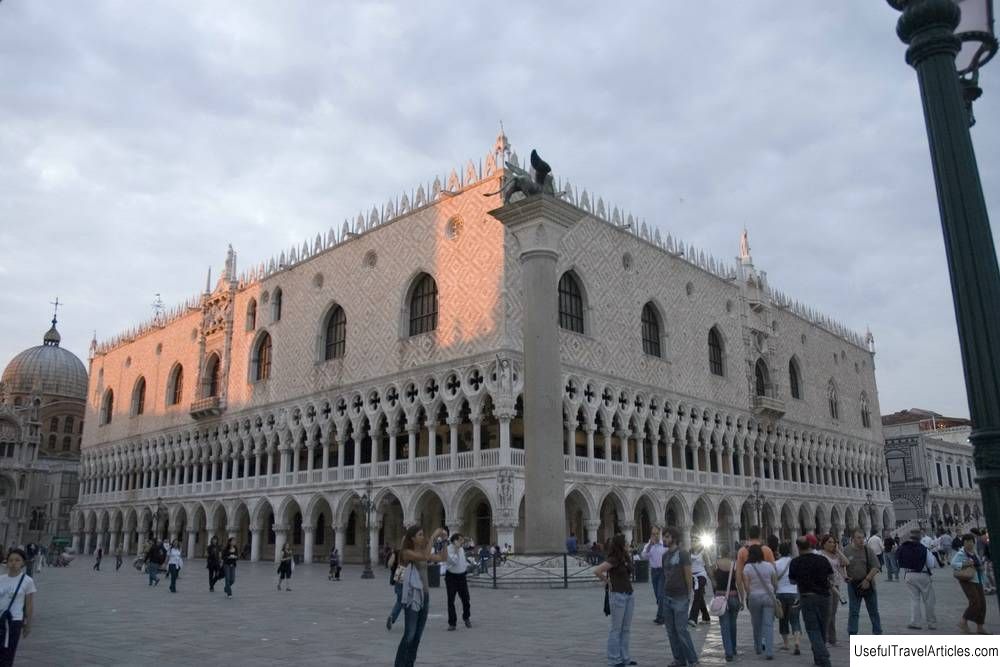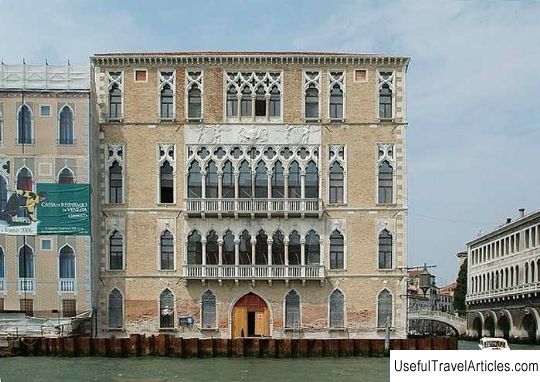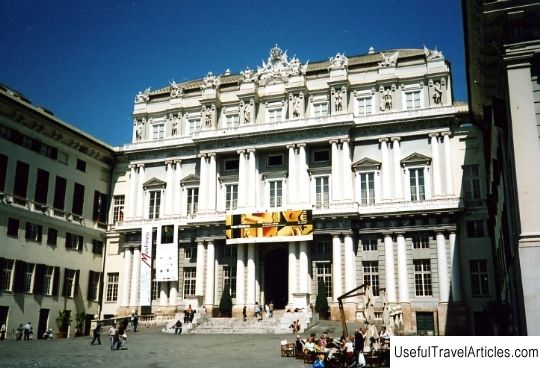Palazzo Ducale description and photos - Italy: Venice
Rating: 8,4/10 (696 votes) 
Palazzo Ducale description and photos - Italy: Venice. Detailed information about the attraction. Description, photographs and a map showing the nearest significant objects. The title in English is Palazzo Ducale. Photo and descriptionThe palace takes its name from the residence of the Doge, the supreme head of the Venetian state. Almost nothing remains of the original structure, built before 1000 on the basis of pre-existing Roman walls. This ancient building was destroyed by fire. Construction of the Doge's PalaceThe current Palace of the Doges was built by stonemasons Filippo Calendario, Pietro Bazeio and master Enrico. In 1400-1404, the facade overlooking the lagoon was completed, and in 1424 the one that overlooked St. Mark's Square. Florentine and Lombard craftsmen were invited to complete the building, but most of the building in the Gothic style was carried out by members of the Bon family, Venetian marble craftsmen. In 1577, another fire destroyed one wing of the building and Antonio da Ponte, the creator of the Rialto Bridge, restored the building to its original appearance. In the center of the eastern facade is a large balcony made by Sansovino's students in 1536. Above the balcony there is a lancet window and a sculpture of the Doge Andrea Gritti in front of the symbol of Venice. Above this balcony is a statue of Justice by the sculptor Alessandro Vittoria. It was from this balcony that the reunification of Venice with the Italian Kingdom was proclaimed in 1866. The paper gate and the facade of the palaceTo the left of the facade, overlooking St. Mark's Square, gives access to the courtyard of the Doge's Palace The Paper Gate - Porta della Carte by Giovanni and Bartolomeo Bon; in the form of a pointed arch, decorated in its upper part with decorative elements in the Gothic style; on the portal - Doge Francesco Foscari in front of a winged lion, and above - a statue of Justice. Through the Paper Gate you can go to the Foscari arched gallery, and then to the courtyard of the Doge's Palace, in the center of which there are two bronze parapets for wells by Alfonso Albergetti (1559) and Niccolo dei Conti (1556), cannon foundry workers. The main facade on the east side of the entrance is by Antonio Rizzo, late 15th century, luxuriously decorated by Pietro Lombardo. The two facades, which flank the courtyard on the south and west sides, were built of red brick by Bartolomeo Manopol in the 17th century. At the top of the northern facade with the Foscari Arch Gallery, there is a clock dial; this facade has two tiers of arches: semicircular in the portico and lancet in the loggia. Niches with antique restored statues stand out in the arched galleries. This facade is also the Baroque work of Manopol. On the right, on a high pedestal, stands a monument to the Duke of Urbino, Francesco Maria della Rovere, by Giovanni Bandini (1587). The Arch of Foscari opens in front of the Staircase of the Giants, begun by the Bon masters in the Gothic style and completed by the architect Rizzo in the Renaissance style. A statue of St. Mark and statues of other allegorical figures. Next to the Giants' Staircase is the Senatorial Court. Traditionally, senators gathered here during solemn ceremonies. Staircase of the Giants and the interiors of the palaceThe Staircase of the Giants takes its name from two huge statues of Mars and Neptune that Sansovino and his disciples sculpted. It was built by Antonio Rizzo at the end of the 15th century. At the top of the stairs, the doge's coronation ceremony was performed. A staircase leads to a covered gallery on the second floor. Lions' mouths are common along the gallery and inside the palace. - engraved heads of lions, into which messages and secret denunciations were dropped, which were the competence of various departments. You can climb the `` Golden Staircase '', designed by Sansovino in 1538 for Doge Andrea Gritti and completed by Scarpanino, to the state rooms of the palace in 1559. The staircase, covered with gilded stucco, in the old days was intended for important guests and dignitaries. In the Scarlatti hall dignitaries of the scarlet togas gathered, waiting for the doge to conduct official ceremonies. The luxurious decoration of this room was carried out under the direction of Pietro Lombardo. The rich wooden ceiling dates back to the early 16th century. The coat of arms of Doge Agostino Barbarigo bears on the elegant marble fireplace. The Hall of Cartes takes its name from the important geographical maps that adorn the walls by Giovan Battista Ramnusio in 1540 and by Francesco Grisellini and Giustino Menescardi in 1762. In the center of the hall there are two large globes dating back to the 17th century. In the hall of the College, the Collegium gathered, consisting of the Doge, six advisers, foremen, the head of the Council of Ten and the Supreme Chancellor. The most important decisions of the government of the republic were made here. This hall was designed by Antonio da Ponte in 1574. The magnificent gilded carved ceiling was created by Francesco Bello and is a frame for allegorical paintings by Paolo Veronese, among which stands out above the podium `` Venice on the Throne. '' The Senate Hall was also reconstructed by Antonio da Ponte. The beautiful ceiling was painted by Cristoforo Sorte from Verona. The panels inserted into it were created by various artists, including Tintoretto. A tribunal sat in the Council Chamber of Ten, which conducted investigations concerning political crimes against the state. The tribunal was chaired by the Doge and consisted of ten Grand Councilors and six councilors. Above this hall were the lead-ceilinged prison cells, the so-called Piombi, in which Giacomo Casanova and Giordano Bruno were once imprisoned. In the center of the ceiling is Paolo Veronese's masterpiece Zeus Strikes Vices with Lightning, which was taken to Paris by the French in 1797 and is still kept in the Louvre. Currently, a copy of this famous painting by Jacopo di Andrea has been installed on this site. The Grand Council Hall occupies the entire southern wing. It is 54 meters long, 25 meters wide and 15 meters high. It was decorated with masterpieces by Titian, Veronese, Tintoretto and other famous artists, but they all died in a fire in 1577. The hall was reconstructed according to the project of Antonio da Ponte. At present, the wall at the back of the hall is completely covered with the painting Paradise, painted by Jacopo Tintoretto and his son Domenico (1590). On the ceiling stands out a huge oval painting by Paolo Veronese `` The Triumph of Venice. '' From the halls of the Office of Laws and the Office of Criminal Cases, you can get into the corridor, which, passing through the Bridge of Sighs, thrown across the Palace Canal, leads to the New Prisons, designed by the architect Antonio da Ponte. Two corridors pass along the bridge: the upper one leads to the New Prisons, and the lower one returns to the portico floor of the Doge's Palace. The Old Prisons included Piombi, located under the lead roof of the Palace, and Pozzi, located at the water level of the Palace Canal, in which the most dangerous prisoners were imprisoned. Pozzi's prison cells, due to their timber cladding and squalid space, give the visitor a gloomy feeling, and one can easily imagine the mood of those who were imprisoned here. Tips
                       We also recommend reading Steindorf am Ossiacher See description and photos - Austria: Lake Ossiachersee Topic: Palazzo Ducale description and photos - Italy: Venice. |




